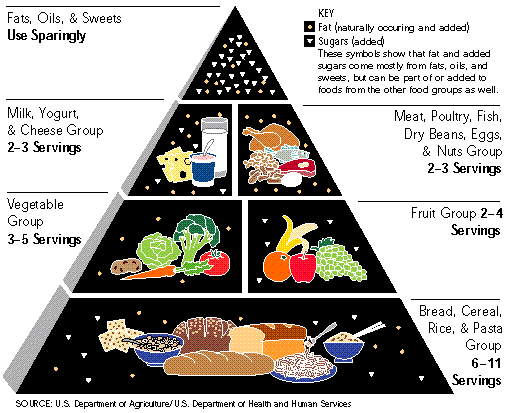The food guide pyramid (more commonly simply called the food pyramid) was introduced as a nutrition guide by the United States Dietary Association. The food guide pyramid suggests optimal nutrition guidelines for every food category per day, using a pyramid with horizontal dividing lines, to represent the suggested percentages of the daily diet for each food group.
The Bread, Cereal, Rice & Pasta Group
This group includes grain products and other foods derived from cereal crops. Cereals, breads, pastas, crackers, and rice fall under this food category. Grains supply us with food energy by way of starch. They are also a source of protein. Whole grains contain important dietary fiber, essential fatty acids, and other important nutrients. Milled grains are however generally more palatable but they also have many nutrients removed in the milling process and are therefore not as highly recommended as whole grains. Whole grains can be found in oatmeal, brown rice, grits, corn tortillas and whole wheat bread.
Six ounces of grain products are recommended per day to maintain a healthy diet.
The Vegetable Group
A vegetable is that part of a plant which is consumed by humans. It is generally savory (not sweet) and differentiated from grains, fruits, nuts, spices and herbs. For example, the stem, root and flower parts of a plant may also be eaten as vegetable. Vegetables contain many vitamins and minerals.
However, different vegetables contain different kinds of vitamins and minerals, so it is crucial to eat a wide variety of vegetables every week and even every day. For example, green vegetables typically contain a large amount of vitamin C, dark orange and dark green vegetables are high in vitamin A content, whereas bushy vegetables like broccoli and related plants contain iron and calcium.
Vegetables are very low in fat and calories but the method of cooking can add fat and calories. Vegetables may be consumed fresh, frozen, canned, or made into juices.
Two and a half cups of vegetables are recommended in our daily dietary intake.
The Fruit Group
With reference to food, rather than the botanical term, fruits are the sweet-tasting seed-bearing parts of plants, or sometimes they are the sweet parts of plants which do not bear seeds.
The fruit group includes oranges, apples, bananas, berries, grapes and plums, and the majority of fruits are low in calories and fat as well as being a primary source of natural sugars, fiber and vitamins.
The processing of fruits for canning or making into juices unfortunately often adds purified sugars and removes essential nutrient. It is therefore more beneficial to consume fresh fruit or canned fruit packed in juice rather than syrup.
It is recommended that we consume 2 cups of fruit in a day.
The Milk, Yogurt and Cheese Group
Dairy products are derived from the milk of mammals, most commonly from the milk of cattle but not always. This group includes milk, cheese and yogurt. Dairy products are the best source for the mineral calcium. They also provide you with protein, phosphorus, vitamin A, and in the case of fortified milk, vitamin D, as well. However, many dairy products are very high in fat as well, and this is why skimmed products are available as a healthier alternative.
The ideal daily intake of the milk, yogurt and cheese group for adults is 3 cups. The recommended amount for kids ages 2-8 is 2 cups.
The Meat, Poultry, Fish, Dry Beans, Eggs & Nuts Group
Since many of the parts of many types of animals are edible, there is a vast variety of meats available for our consumption. Meat has long been recognized as a primary source of dietary protein, as well as providing a good percentage of your daily iron, zinc, and vitamin B requirements. The different kinds of meats include beef, chicken, pork, salmon, tuna, and shrimp, etc.
Many of the same nutrients that are found in meat can also be found in foods such as eggs, dry beans, and nuts. This is the reason that such foods are in the same category as meats and in fact, they are often treated as viable meat alternatives. They include tofu and products that resemble meat or fish but are actually made from soy, eggs and cheese.
Although meats are a potent source of energy and nutrients, they are often quite high in fat and cholesterol as well as sodium. However, something as simple as trimming off fatty tissue can go a long way towards reducing the negative effects of meat.
It is recommended that we consume two 5 ½ ounces of meat or meat alternatives in a day.
The Fats, Oils and Sweets Group
The fats, oils, and sweets group is right at the top of the food pyramid because it is the smallest section. This means that while they do have nutritional value, they should be consumed minimally.

 Introduction To Of Some Lower Cholesterol Foodstuffs
Cholesterol is a fat-like element contained in the physique
Introduction To Of Some Lower Cholesterol Foodstuffs
Cholesterol is a fat-like element contained in the physique
 The Simplest Way To Lessen Your High Cholesterol By Natural Means
High-cholesterol is a major variable inside the countrywide
The Simplest Way To Lessen Your High Cholesterol By Natural Means
High-cholesterol is a major variable inside the countrywide
 Starting Up An Aquaponics Set Up From See The Easy Way
Planting seeds in your aquaponics system can be a lot simpl
Starting Up An Aquaponics Set Up From See The Easy Way
Planting seeds in your aquaponics system can be a lot simpl